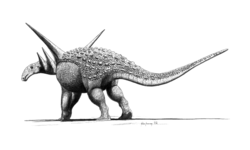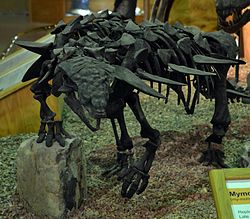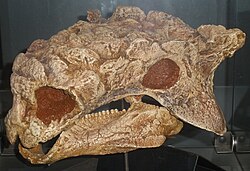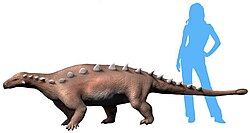
This timeline of ankylosaur research is a chronological listing of events in the history of paleontology focused on the ankylosaurs, quadrupedal herbivorous dinosaurs who were protected by a covering bony plates and spikes and occasionally by a clubbed tail. Although formally trained scientists did not begin documenting ankylosaur fossils until the early 19th century, Native Americans had a long history of contact with these remains, which were generally interpreted through a mythological lens. The Delaware people have stories about smoking the bones of ancient monsters in a magic ritual to have wishes granted and ankylosaur fossils are among the local fossils that may have been used like this. [1] The Native Americans of the modern southwestern United States tell stories about an armored monster named Yeitso that may have been influenced by local ankylosaur fossils. [2] Likewise, ankylosaur remains are among the dinosaur bones found along the Red Deer River of Alberta, Canada where the Piegan people believe that the Grandfather of the Buffalo once lived. [3]
Contents
- Prescientific
- 19th century
- 1830s
- 1840s
- 1850s
- 1860s
- 1870s
- 1880s
- 1890s
- 20th century
- 1900s
- 1910s
- 1920s
- 1930s
- 1940s
- 1950s
- 1960s
- 1970s
- 1980s
- 1990s
- 21st century
- 2000s
- 2010s
- 2020s
- See also
- Footnotes
- References
- External links
The first scientifically documented ankylosaur remains were recovered from Early Cretaceous rocks in England and named Hylaeosaurus armatus by Gideon Mantell in 1833. [4] However, the Ankylosauria itself would not be named until Henry Fairfield Osborn did so in 1923 nearly a hundred years later. [5] Prior to this, the ankylosaurs had been considered members of the Stegosauria, which included all armored dinosaurs when Othniel Charles Marsh named the group in 1877. It was not until 1927 that Alfred Sherwood Romer implemented the modern use of the name Stegosauria as specifically pertaining to the plate-backed and spike-tailed dinosaurs of the Jurassic that form the ankylosaurs' nearest relatives. [6] The next major revision to ankylosaur taxonomy would not come until Walter Coombs divided the group into the two main families paleontologists still recognize today; the nodosaurids and ankylosaurids. [5] Since then, many new ankylosaur genera and species have been discovered from all over the world and continue to come to light. Many fossil ankylosaur trackways have also been recognized. [7]
























